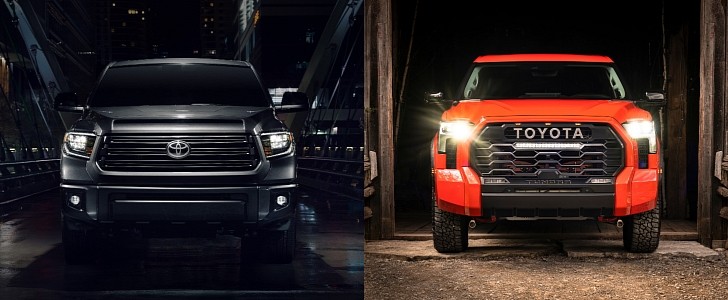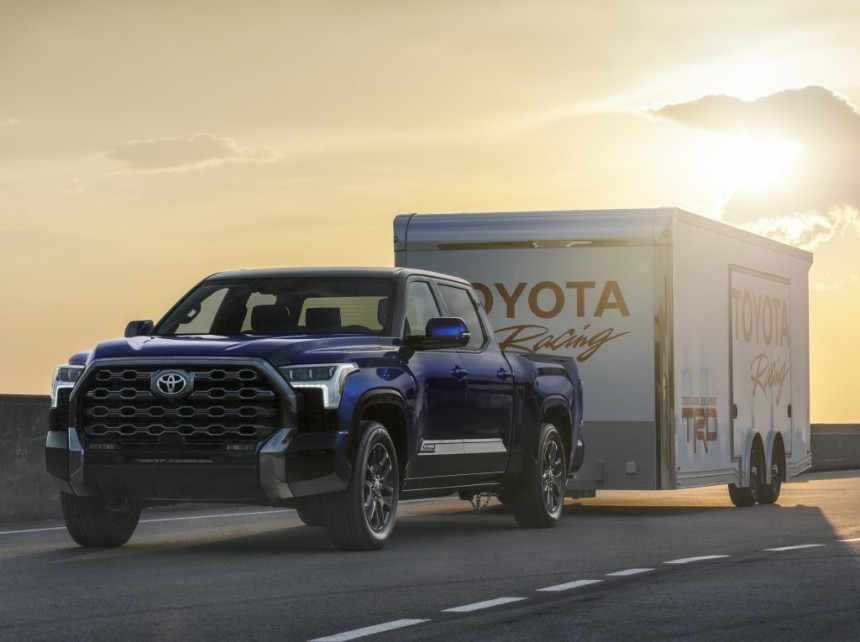Manufactured in Princeton between 2007 and 2009, then in San Antonio through 2021, the second-gen Tundra is no more. Toyota redesigned the half-ton pickup truck from the ground up for the 2022 model year, and the newcomer couldn’t be more different from its precursor.
The first and biggest change we have to highlight is the frame. Toyota calls the brand-new platform TNGA-F, and the first application for the body-on-frame architecture is the J300 Land Cruiser. As opposed to the open C-frame of the previous Tundra, we’re now dealing with a fully-boxed setup.
I won’t be taking sides on this matter because there’s a hot debate in the pickup truck community about which is better. But I do want to mention that a boxed frame is stronger than open-channel members, which is why Toyota is quoting superior payload and towing capacities for the 2022 model.
When properly configured for the job, the all-new Tundra can haul 1,940 pounds (880 kilograms) or pull 12,000 pounds (5,443 kilograms). By comparison, the 2021 model makes do with 1,730 and 10,200 pounds (785 and 4,627 kilograms). By significantly improving rigidity over the previous generation, Toyota had to widen the rear member to improve stability.
Frame crossmembers are more than doubled in size, and a front crossmember was constructed for the steering box for extra rigidity. Switching to the TNGA-F platform also translates to a fresh approach to suspension technology, as in coil springs instead of old-school leaf springs for the multi-link rear axle.
Toyota's North American and Japanese engineers decided to mount the shock absorbers outside the frame rails for improved roll damping and towing performance, and the lateral control arm provides increased lateral rigidity.
For the peeps who intend to use the Tundra for fifth-wheel or gooseneck towing, optional airbags in the rear help reduce the sag when the trailer is loaded up. These airbags can be manually dropped to help with easing away from a hitch. Customers are presented with three height modes: normal, high for slow-speed driving, as well as low for much easier loading and unloading.
A total of three bed lengths are offered: 5.5 and 6.5 feet for the CrewMax and 6.5 or 8.1 feet for the Double Cab. All of them are light yet strong thanks to reinforcing aluminum crossmembers and Sheet-Molded Compound construction. The mid-sized Toyota Tacoma features a composite bed as well, and it’s the right call if you ask me because the SMC design offers better protection against rust, impact dings, and the oh-so-common dents.
Safety is another highlight of the 2022 model over the 2021 Tundra. Toyota Safety Sense 2.5 comes standard from the base SR up to the plushy 1974 and off-road TRD Pro trim levels with goodies that include a pre-collision system with pedestrian detection in low-light conditions. Emergency steering assist, dynamic radar cruise control, lane departure alert, lane tracing assist, automatic high beams, road sign assist, rear seat reminder, rear cross traffic alert, as well as blind spot monitoring pretty much seal the deal.
From the standpoint of design, it’s hard to warm up to the massive front grille. Given time, it’s certain to grow on most of us although some people can’t help but associate that face with a largemouth bass. The cabin is miles ahead of the 2021 model year Tundra thanks to a horizontal layout theme and tons of soft-touch materials in high-contact areas such as the armrests.
And finally, Toyota made the fateful decision to switch from a free-breathing V8 to a couple of twin-turbo V6s. The standard engine, which is dubbed i-Force, is rocking 389 horsepower and 479 pound-feet (650 Nm) from 3.4 liters of displacement although Toyota falsely advertises it with 3.5 liters.
The i-Force Max is pretty much the same thing albeit with hybrid assistance, which levels up the output ratings to 437 horsepower and 583 pound-feet (790 Nm). Both of them are connected to a smooth 10-speed automatic transmission, and both V6 mills outperform the venerable V8 engine.
I won’t be taking sides on this matter because there’s a hot debate in the pickup truck community about which is better. But I do want to mention that a boxed frame is stronger than open-channel members, which is why Toyota is quoting superior payload and towing capacities for the 2022 model.
When properly configured for the job, the all-new Tundra can haul 1,940 pounds (880 kilograms) or pull 12,000 pounds (5,443 kilograms). By comparison, the 2021 model makes do with 1,730 and 10,200 pounds (785 and 4,627 kilograms). By significantly improving rigidity over the previous generation, Toyota had to widen the rear member to improve stability.
Frame crossmembers are more than doubled in size, and a front crossmember was constructed for the steering box for extra rigidity. Switching to the TNGA-F platform also translates to a fresh approach to suspension technology, as in coil springs instead of old-school leaf springs for the multi-link rear axle.
Toyota's North American and Japanese engineers decided to mount the shock absorbers outside the frame rails for improved roll damping and towing performance, and the lateral control arm provides increased lateral rigidity.
For the peeps who intend to use the Tundra for fifth-wheel or gooseneck towing, optional airbags in the rear help reduce the sag when the trailer is loaded up. These airbags can be manually dropped to help with easing away from a hitch. Customers are presented with three height modes: normal, high for slow-speed driving, as well as low for much easier loading and unloading.
Safety is another highlight of the 2022 model over the 2021 Tundra. Toyota Safety Sense 2.5 comes standard from the base SR up to the plushy 1974 and off-road TRD Pro trim levels with goodies that include a pre-collision system with pedestrian detection in low-light conditions. Emergency steering assist, dynamic radar cruise control, lane departure alert, lane tracing assist, automatic high beams, road sign assist, rear seat reminder, rear cross traffic alert, as well as blind spot monitoring pretty much seal the deal.
From the standpoint of design, it’s hard to warm up to the massive front grille. Given time, it’s certain to grow on most of us although some people can’t help but associate that face with a largemouth bass. The cabin is miles ahead of the 2021 model year Tundra thanks to a horizontal layout theme and tons of soft-touch materials in high-contact areas such as the armrests.
And finally, Toyota made the fateful decision to switch from a free-breathing V8 to a couple of twin-turbo V6s. The standard engine, which is dubbed i-Force, is rocking 389 horsepower and 479 pound-feet (650 Nm) from 3.4 liters of displacement although Toyota falsely advertises it with 3.5 liters.
The i-Force Max is pretty much the same thing albeit with hybrid assistance, which levels up the output ratings to 437 horsepower and 583 pound-feet (790 Nm). Both of them are connected to a smooth 10-speed automatic transmission, and both V6 mills outperform the venerable V8 engine.





















